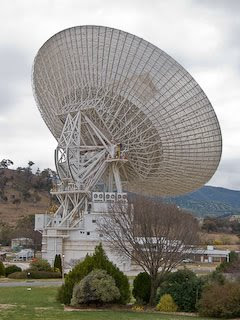 < Drynaria fern 'nest leaves'
< Drynaria fern 'nest leaves'Living with a native Canberran means I can be as curious as I like about Canberra without feeling nosy or intrusive. My Web design work takes up only a few hours a day, leaving the rest for day trips to places like the Australian National Botanic Gardens (ANBG), the Mount Stromlo Observatory, and the Canberra Deep Space Communication Complex at Tidbinbilla.
The Botanic Gardens, a wonderful collection of unique Australian flora, is on nearby Black Mountain. About 99,000 plants representing more than 6,800 species are cultivated. Each section of the garden is based on a theme, like Rainforest Gully, the Rock Garden, the Eucalypt Lawn and the Mallee Shrublands. There is a hot house with native orchid species and rare ferns that's open to the public, and a nice patio cafe at which to sip coffee and eat pies or pastry when you need a break from the hike around the gardens.
The birds in the ANBG are oblivious to visitors, and it's a haven for bird watchers. The Choughs (pronounced "chuffs") and Red Wattlebirds are very cheeky and practically demand to be fed. The day was overcast, but David took some photos anyway. We plan to return for more photos when the weather's a bit warmer and sunnier. See the latest gallery.
 < The main dish at Tidbinbilla
< The main dish at TidbinbillaMount Stromlo Observatory is part of the Research School of Astronomy and Astrophysics at the Australian National University (ANU). The site of the observatory offers a spectacular view of the city. On January 18, 2003 a firestorm hit Mount Stromlo destroying five telescopes, workshops, seven homes, a priceless library, and the administration building. The ruins of the 50 inch Great Melbourne telescope are visible from the visitors parking lot.
We ran into a friend of David's, radio astronomer Dr. David Jauncey, who shared some fascinating stories about the fire. Dr Jauncey mentioned that the employees at the Canberra Deep Space Communication Complex, our next destination (twenty miles away) were trapped by the fire there and battled it themselves. Amazingly, no one was injured and no damage was done to the facility.
The Canberra Deep Space Communication Complex is part of the Deep Space Network run by NASA's Jet Propulsion Laboratory (JPL). It is commonly referred to as the Tidbinbilla Deep Space Tracking Station. It is the only NASA tracking station in Australia still in operation, and is the largest antenna complex in the southern hemisphere. The four large antennas receive data from spacecraft, like the Mars rover, exploring our Solar System and beyond. The visitor center offers an excellent view of the largest dish, a piece of the Moon that's over 3.8 billion years old, the latest images from Mars, spacecraft models, and real, flown space hardware. The cafe and gift shop is open everyday for meals. There is a playground for children, and picnic areas from which to enjoy magnificent views of the Tidbinbilla valley.
The day we drove up Mount Stromlo (visible from David's house, in the distance) was quite cold, so we didn't take any photos there. The more sheltered Tidbinbilla valley offered better photographic opportunities (see the photo gallery).
1 comment:
Hi Linda - so glad you are doing the sites/sights. Another place well worth a visit is the bushfire memorial on the Cotter Road. I have a brick in the wall there.
xxx Susan
Post a Comment